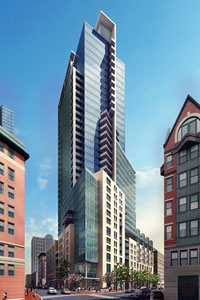101 Clarendon Street facts for kids
Quick facts for kids 101 Clarendon Street |
|
|---|---|
 |
|
| General information | |
| Status | Never built |
| Type | Hotel, Parking garage, Residential, Retail, Fitness center |
| Location | 101 Clarendon Street, Boston, Massachusetts |
| Coordinates | 42°20′54.69″N 71°4′26.46″W / 42.3485250°N 71.0740167°W |
| Height | |
| Roof | 420 ft (130 m) |
| Technical details | |
| Floor count | 35 |
| Design and construction | |
| Architect | Childs Bertman Tseckares Inc. |
| Developer | Winn Development |
101 Clarendon Street, also known as Columbus Center, was a very tall building planned for Boston, Massachusetts. If it had been built, it would have been one of the tallest buildings in Boston. This project was designed to build over the Massachusetts Turnpike (a major highway). It would have used "air rights," which means building in the space above existing structures.
The planned location for the building was right above the turnpike. It would have been near Back Bay station and Copley Square in the Back Bay area of Boston. The idea was that this building would help connect the city’s Back Bay and South End neighborhoods.
Why the Project Paused
In March 2008, the building project was put on hold. The people developing it said they needed about $35 million in money and loans from the state. Some of this money was not given to them because construction had already stopped. This made it difficult to continue.
Project Ends
By 2010, the main company helping to pay for Columbus Center, called the California Pension and Retirement System (CalPERS), started to pull out of the project. They felt that the project was too expensive and would not make enough money. Also, some local people were strongly against the project.
Because of these reasons, the $800 million building plan was officially stopped by CalPERS and the developer, Arthur Winn. There were still discussions about how much it would cost to clean up the proposed building site, which was estimated to be around $5 million to $6 million.
Future Plans
As of 2016, two different groups of developers were interested in trying to start the project again. They hoped to bring the idea of 101 Clarendon Street back to life.

